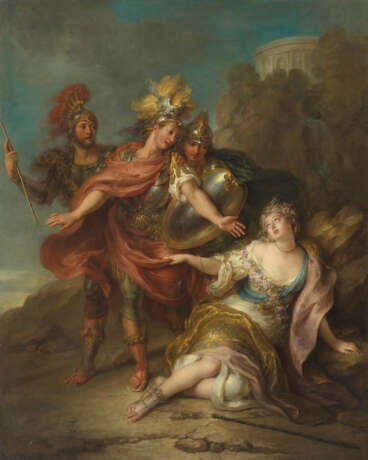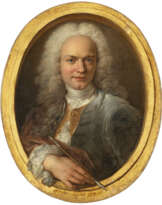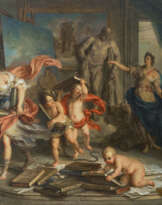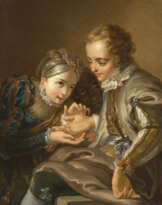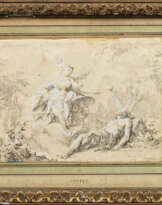ID 1071551
Lot 23 | CHARLES-ANTOINE COYPEL (PARIS 1694-1752)
Estimate value
€ 200 000 – 300 000
Renaud abandonnant Armide
signé 'C AN . COYPEL' (en bas, à gauche)
huile sur toile
100 x 80,3 cm. (39 1⁄3 x 31 2⁄3 in.)
Provenance
Peut-être vente après-décès de l'artiste, Paris, 27 mars 1753, lot 119 (comme 'Renaud quittant le Palais d'Armide ; Tableau qui a été gravé par le fieur Joullain ; & une Efquiffe d'un Tableau que le même auteur méditoit, & dont le fujet devoit être une des fcenes de l'Opéra d'Alcefte' (selon T. Lefrançois, 1994, op. cit. infra).
Dans la famille Rothschild, Paris, France, depuis la fin du XIXe siècle ou les premières années du XXe siècle ; puis par descendance au baron Élie de Rothschild (1917-2007), hôtel de Masseran, Paris, France ; puis par descendance à l'actuel propriétaire.
Literature
Anonyme, Mercure de France dédié au Roy, septembre 1725, II, p. 2268.
A. Siret, Dictionnaire historique des peintres de toutes les écoles depuis l'origine de la peinture jusqu'à nos jours, Paris, 1876 (réédition de 1833 et 1866), p. 225.
Peut-être H. Mireur, Dictionnaire des ventes d'art faites en France et à l'Étranger pendant les XVIIIe et XIXe siècles, Paris, 1902, II, p. 305.
G. Wildenstein, Le Salon de 1725. Compte rendu par le Mercure de France de l'Exposition faite au Salon Carré du Louvre par l'Académie royale de peinture et de sculpture en 1725 publié avec des notes et documents nouveaux sur les expositions de l'Académie pendant le XVIIIe siècle, Paris, 1924, p. 48.
I. Jamieson, Charles-Antoine Coypel. Premier Peintre de Louis XV et Auteur Dramatique (1694-1752). Sa vie et son oeuvre artistique et littéraire d'après des documents inédits, suivies d'une de ses comédies inédites, Paris, 1930, pp. 7-8.
D. Cooper, Les Grandes Collections Privées, Paris, 1963, reproduit en couleurs in situ sur la jaquette.
P. Du Colombier, 'Le sanctuaire de Watteau', Les Nouvelles littéraires, 14 mars 1968, p. 8, reproduit en noir et blanc p. 8.
A. Chastel, 'La génération de Watteau', Le Monde, 14 mars 1968, [en ligne], consulté le 21 septembre 2023 : https://www.lemonde.fr/archives/article/1968⁄03/14/la-generation-de-watteau_2506469_1819218.html.
F. E., 'Watteau et sa génération', Carrefour des idées, des arts, des lettres, des sciences, 20 mars 1968, 1227, p. 16.
A. Schnapper, 'Musées de Lille et de Brest. A propos de deux nouvelles acquisitions : "Le chef-d'oeuvre d'un muet" ou la tentative de Charles Coypel', La Revue du Louvre et des musées de France, 1968, 18e année, 4-5, p. 256.
W. von Kalnein, M. Levey, Art and Architecture of the Eighteenth Century in France, Harmondsworth-Baltimore-Ringwood, 1972, pp. 28-29 et xi, reproduit en noir et blanc pl. 24.
H. Oursel, in La peinture française aux XVIIe et XVIIIe siècles, coll. Trésors des musées du nord de la France, [cat. exp.], Dunkerque-Valenciennes-Lille, 1980, IV, p. 135.
M. Levey, L'art du XVIIIe siècle. Peinture et sculpture en France 1700-1789, Paris, 1993, (traduit de l'anglais par J.-F. Allain), p. 51, reproduit en noir et blanc p. 51, n°46.T. Lefrançois, Charles Coypel. Peintre du roi (1694-1752), Paris, 1994, p. 80 et pp. 198-200, n°P. 56, reproduit en noir et blanc p. 199.
J. E. Mercurio, Staging Alliances: Redifining Painting and Music in Early Eighteenth-Century France, dissertation in the History of Art, University of Pennsylvania, 2006, p. xii, n°6.4, reproduit.
Exhibited
Paris, Salon Carré du Louvre, Salon, 1725, n°48.
Paris, galerie Cailleux, Watteau et sa génération, mars-avril 1968, n°108.
Further Details
CHARLES-ANTOINE COYPEL, ARMIDA ABANDONED BY RINALDO, SIGNED, OIL ON CANVAS
Rinaldo Abandoning Armida is being offered at auction for the first time in over 250 years. It last appeared on the 27th March 1753, the date of the artist's posthumous sale. At the end of the Nineteenth Century, the painting was acquired by the Rothschild family, and has remained in the possession of the prestigious family of collectors ever since.
The artist, who came from an illustrious family of painters, proved his brilliance from an early age, both in terms of his artistic talent and his diplomatic and strategic skills that allowed him to rise quickly to the highest positions in the art world. He became a member of the Académie de peinture et de sculpture in 1715 (aged just 19), and Keeper of the Crown's Paintings and Drawings in 1722 (aged 28).
Proudly signed, the present painting was exhibited at the Salon of 1725. The young artist wished to use this work to demonstrate his virtuosity and his ability to equal his elders and closest rivals such as Jean François de Troy (1679-1752) and François Lemoyne (1688-1737). He wanted to lend a new and personal dynamic to the great revival of the genre of history painting. Rinaldo Abandoning Armida is thus an important work, in which the young artist, buoyed by his success, can be seen to assert himself as the great master he would become in the following decades, a success that culminated in his appointment as first painter to King Louis XV (1710-1774) in 1747. This composition was engraved by François Joullain (1697-1778) (fig. 1), and there is most likely another, smaller-format painted version, which appeared in several eighteenth-century auctions.
The scene is taken from Jerusalem Delivered by Tasso (1544-1595). Armida, a Saracen magician, desired to kill the crusader Rinaldo. To achieve her end she lulled him into a deep sleep, however, just as she was about to strike him with her dagger, Cupid transformed her hatred into love. Following this change of heart, Armida decided to transport the sleeping hero to her enchanted island. There Rinaldo remained bewitched until his friends Carlo and Ubaldo came to free him. It is this final moment that Coypel chose as the subject of his painting. Tasso's epic inspired many artists over the centuries, but it is rare to find a depiction of the end of the story.
More specifically, Coypel drew his inspiration from the libretto of the opera Armida written by Philippe Quinault (1635-1688) and set to music by Jean-Baptiste Lully (1632-1687), first performed in 1686. The opera features the passage depicted by the painter, in which Armida faints in distress at the departure of Rinaldo (Act V scene IV). Coypel used typical theatrical gestures to choreograph his composition and give great dramatic intensity. The strong triangular composition also lends the painting power and contributes to the drama of the scene. Further drawing on these operatic roots, Coypel gives his characters shimmering baroque costumes, which allowed him to show off his adept handling of colour.
Rinaldo Abandoning Armida is the quintessence of Charles-Antoine Coypel’s art and the perfect illustration of Pierre Rosenberg's words, taken from the preface to the monograph on the artist published by Thierry Lefrançois for Arthena in 1994:
There was a Boucher style. There is also a Coypel style. Coypel loved to paint the theatre [...] He persevered in believing (like Füssli half a century later) that to paint the theatre was to paint life. He thought he could update Ut pictura poesis by replacing the word 'poetry' with 'theatre'.
A note on the provenance:
Undoubtedly a key work in Coypel's career, the painting remained in the painter’s own collection until his death, when it featured in his posthumous sale. At the end of the Nineteenth Century, the work then came into the possession of the Rothschild family, one of Europe’s most notable dynasties of collectors. More specifically, Rinaldo Abandoning Armida appears in the collection of the young Élie de Rothschild (1917-2007), who not only inherited a prodigious collection from his grandfather and great-grandfather, Baron Gustave (1829-1911) and Baron James (1792-1868), founder of the French branch of the family, but who also enlarged and displayed it with the aesthetic flair so characteristic of Rothschild taste. In 1955, he acquired the mansion of Count Étienne de Beaumont (1883-1956) on rue Masseran in Paris. This was the ideal setting for the collection. Refined eighteenth-century furniture and collections of cameos and enamels were displayed alongside some of the greatest paintings in private hands. Indeed, Rinaldo Abandoning Armida hung in the Salon Vert alongside one of the masterpieces of seventeenth-century Dutch painting, Rembrandt’s Standard Bearer (fig. 2), currently on display in the Rijksmuseum.
| Artist: | Charles-Antoine Coypel (1694 - 1752) |
|---|---|
| Applied technique: | Oil on canvas |
| Art style: | Old Masters |
| Place of origin: | Western Europe, France, Europe |
| Auction house category: | Paintings |
| Artist: | Charles-Antoine Coypel (1694 - 1752) |
|---|---|
| Applied technique: | Oil on canvas |
| Art style: | Old Masters |
| Place of origin: | Western Europe, France, Europe |
| Auction house category: | Paintings |
| Address of auction |
CHRISTIE'S 9 Avenue Matignon 75008 Paris France | ||||||||||||||
|---|---|---|---|---|---|---|---|---|---|---|---|---|---|---|---|
| Preview |
| ||||||||||||||
| Phone | +33 (0)1 40 76 85 85 | ||||||||||||||
| Fax | +33 (0)1 40 76 85 86 | ||||||||||||||
| Conditions of purchase | Conditions of purchase | ||||||||||||||
| Shipping |
Postal service Courier service pickup by yourself | ||||||||||||||
| Payment methods |
Wire Transfer | ||||||||||||||
| Business hours | Business hours
|
